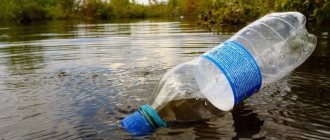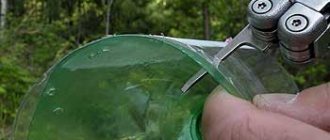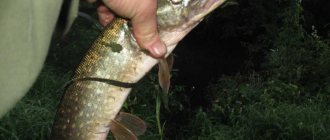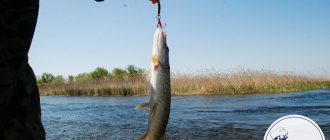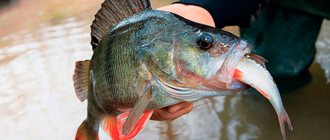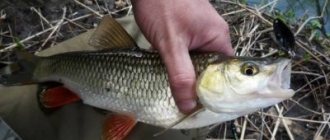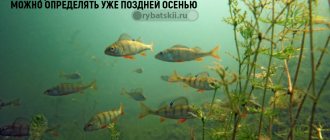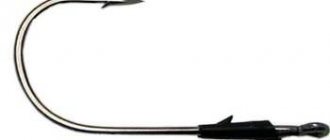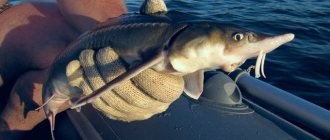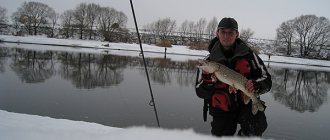- November 2, 2018
- Miscellaneous
- Andrey Raiter
Live bait fishing is one of the most effective ways of catching predatory fish. But this same method is also considered the most problematic, as it is associated with various nuances of preparing and storing bait. One of the key questions: how to quickly catch live bait in the summer? The warm period is the most attractive from the point of view of organizing such fishing, which is why the majority of fishermen who adhere to this tactic become active at this time.
What kind of fish do you use to make live bait?
Not all underwater fauna is suitable for creating live bait, even if we are talking about suitable sizes. Of course, every small fish and fry has its own predator, but the requirements include not only the taste preferences of the caught pike or perch. It is important to consider qualities such as survival and transportability of live bait. In the summer we catch fish that are also able to remain attractive to predators through their behavior, and this is also a question of the survivability of the bait.
As practice shows, the most valuable live bait is obtained from the following fish:
- Crucian carp. It is distinguished by its vitality and universal taste properties, which attract a wide variety of predators. A simple, universal and common bait in Russian conditions.
- Loach. A very rare type of live bait that not only retains the appearance of a living prey, but also shows an interesting trolling game. During the fishing process, you can use both standard gear and a donkey with wiring. As for the target fish, the loach is also universal, but it is more often used for pike.
- Rotan. Also an attractive prey for pike, as well as perch. However, it is summer time that is not the most favorable for rotan.
- Gudgeon. It appeals to a variety of predators, but its vitality is low.
- Perch. And this fish is not famous for its long survival time, but in favorable conditions it can be used to catch very large specimens of pike and pike perch.
- Top melter. Like crucian carp, it is able to withstand the harshest conditions, being an attractive prey for rotan, perch and pike. But it is very important to choose the right moment when the predator itself moves closer to the upper warm layers of reservoirs and lakes, where the apex swimmer lives.
- Rudd. It is a rare case when a fish not only lives in a river, but also performs well as bait in the same conditions. Another question: how to catch live bait from rudd in the summer so that it retains the desired characteristics even outside the water? And for this, at a minimum, you will need special compressors with autonomous power supply. There is no point in saving on such equipment, since together with roach, this fish can provide a good catch.
- Bleak. Both from a boat and from the shore, bleak can be caught at any time of the year using a regular fishing rod with wiring. Next, you can focus on perch and pike, which will willingly rise from the bottom to snack on pelagic fish.
- Ruff. If you have a clear goal of catching burbot, then you can safely cook ruff. But it should be applied as quickly as possible, since it does not last long in warm conditions.
Homemade trap for catching live bait in the water column
It happens that you come fishing and nothing bites, but you often watch how a perch or other predator chases the fry along the top.
This is where the question arises, where to get live bait, because it is quite problematic to take a spider with you every time. So one fisherman came up with the idea of how to make a compact trap for catching fry from scrap materials. For these purposes you will need a minimum of materials; all of them can be found at home without any problems. Video on how to make a bottle trap with your own hands
The main feature of such a trap is that it does not sink to the bottom, but floats in the water column. With this approach, you can catch much more fry, since they are concentrated in the upper layers. In addition, the trap can be adjusted in depth. The author used ordinary plastic bottles as the main material.
Materials and tools: - two plastic bottles (the larger they are, the larger the trap will be); - scissors; - an awl or a large needle; - a piece of foam plastic; - any metal object for a sinker; - scissors and knife; - rope and two carabiners.
Step one. Manufacturing of blanks
The blanks will be created from plastic bottles. Take the first bottle and cut off its neck, that is, the narrow part. Next you need to cut the bottle at the widest part. You can see exactly how in the photo.
After this, take the second bottle and cut it at the widest part. As a result, you will get two elements, this is part of the bottle in the form of a watering can and part in the form of a vase or cylinder.
The main point here is that the watering can part of the bottle fits tightly into the second part of the bottle. As a result, an almost finished trap comes out.
The other ends of the ropes are attached to the trap. For these purposes, you need to make several holes in the bottle and install wire loops. The loops should be on the opposite side of the side where the sinker is installed. At the final stage, the main rope is tied to the load of the trap or any other place, by which the trap will be removed.
How the trap works
First, you need to put a piece of bread or flour in the trap. Then this entire system is sent into the reservoir. This can be done not only from a boat, but also from a steep bank, a bridge, or even simply by throwing a trap into the water from the shore.
In order for the fry to be removed, you need to remove the insert part from the bottle. Now the fry can be removed and moved to a larger container where it can live longer.
In this simple way you can always catch live bait. Source
Basic methods of catching live bait
There are several popular methods of catching live bait, each of which has its own technical and design features. The choice of a specific method should be based on the species of the target fish and the fishing location. So, how to catch live bait in the summer?
The most common ways to solve this problem are described below:
- Using a fishing rod with a float from the shore. This method is used to catch small crucian carp, rotan, gudgeon, roach and perch. Experienced fishermen advise catching live bait in the same body of water where you plan to hunt predators. In reservoir conditions, you can use donka, screening out what you catch based on size and appearance.
- On a fishing rod with a float from a boat. The best option for searching for live bait in river bays, overgrown creeks and where it is impossible to reach from the shore. The target objects in this case will be rudd and roach. Harvesting can be done both in summer and spring.
- Mesh. An effective approach to catching live bait in the summer on river shallows and in ponds. A regular fishing net with bread-based bait is used. A variety of little things can fall into such a trap, so the method is cheap and universal.
- A spider trap. Also the best option if you plan to use improvised methods. How to catch live bait in the summer using a spider? In essence, this is the same grid, but more manageable. It is called a spider for the reason that its corners are connected by thin metal rods with the ability to slam shut. The structure is immersed to a certain depth with bait and pulled out with small fish. In this way you can catch both roach with crucian carp and bleak with top-melting fish.
Catching live bait with traps
One of the most common ways to catch fry. Traps are made from different containers, for example, from a plastic canister in which holes are made. A piece of bread is placed in it and within a few minutes the container is full of fry.
Catching live bait with your snout
A muzzle - a device for catching fry is not difficult to make yourself. This is a container made of metal mesh to which a rope is tied. By throwing such a net, you can catch many fry at one time. You can see the effectiveness of the muzzle by watching the video.
Watch the video: Catching live bait with your snout. How to catch live bait?
Catching live bait with a plastic eggplant trap and making it
- We cut off the upper part of the container (about 5 liters), where the narrowing begins.
- We insert the cut part with the neck inside the container and secure it with wire.
- We make holes around the perimeter of the container using a knife; there should be a lot of holes, but not large ones.
- We tie the container with a rope and attach a weight to the rope, otherwise the plastic container will not sink under the water.
- We throw in complementary foods or just crusts of bread.
- We check the catch after half an hour.
Watch the video: Fishing for live bait. The most effective way to catch live bait
Catching live bait on a lift or spider
If you also lure the fish with complementary food, sprinkle a little bran, which will create a cloud, and then a school of fry can be picked up using a landing net or spider.
A spider is a metal frame that can be disassembled, covered with a fine-mesh mesh.
You can catch with fine-mesh nets - larvae. They are lowered to the bottom with bait made from bread crusts.
Watch the video: Fishing for live bait using a lift
Catching live bait with a float rod
The method of catching live bait using a float rod is very popular. The advantage of this method is that it is enough to take with you a light fishing rod, a small hook, and a light float.
As soon as you catch the first live bait, you can put it on the predator, and continue to harvest the fry yourself. This method is suitable for fry of perches, ruffes and minnows.
All the methods described above are more suitable for summer. How to catch live bait in winter?
How to catch live bait in the summer using a bottle?
Various types of traps for catching live bait are made from plastic bottles of different sizes, but in this case the most thorough and effective one will be considered. The work will require a regular 5-liter plastic bottle, which will only need to be slightly altered. The instructions for making a means for catching live bait of this type are as follows:
- The cap and neck of the bottle are removed.
- The part with the neck is turned over and placed with the reverse side in the niche of the bottle.
- Using an awl and thin wire, you need to sew the neck to the side edges of the cut container.
As you can see, the result is a fairly simple and affordable design. How does this method of catching live bait in the summer work? It should be used in shallow water, where there are small fish like roach or perch. The structure is buried in the ground under water to the level of the cut line. As bait, which is pre-placed at the bottom, you can use something odorous such as a slurry of bread, cake and sunflower. The attracted fish will fall to the bottom through the hole in the neck and remain there.
In the same way, you can use a 3-liter glass jar, providing a gauze pad instead of a lid in the passage part. A small slot of 3-4 cm is made in it, and the same bait is placed inside. At a good time, as the fishermen themselves claim, in this way you can lure up to a dozen fish in half an hour.
How to catch live bait in the summer: types, gear, fishing methods and ways to preserve live bait
- November 2, 2018
- Miscellaneous
- Andrey Raiter
Live bait fishing is one of the most effective ways of catching predatory fish. But this same method is also considered the most problematic, as it is associated with various nuances of preparing and storing bait. One of the key questions: how to quickly catch live bait in the summer? The warm period is the most attractive from the point of view of organizing such fishing, which is why the majority of fishermen who adhere to this tactic become active at this time.
What should you know about catching whitebait?
Any body of water annually spoils local fishermen with bursts of changes in the population of a certain type of fish. This could be, for example, the activation of fry of sprat or sabrefish, which feed on predators such as pike perch, pike and perch. Actually, the target catch of the average fisherman in Russian conditions. But you can focus on large sizes only when catching crucian carp, bleak or gudgeon with fry. In any case, the main task is to correctly record the activity of the population and determine the target object of fishing.
How to catch fry in the summer for live bait? To begin with, it is worth considering that the mouth of fry is very small, so special lifts made of a wire metal frame and fine mesh are often used to prepare it. When harvesting on rivers, fishing with a lift is technically complicated. On small rivers you may not expect any results at all. In addition, the lift structures are quite cumbersome, and carrying them along with other equipment is extremely inconvenient. Therefore, the use of various types of traps with bait in the form of waste is increasingly practiced. Such devices will be discussed below.
How to make a trap for catching fry from a plastic five-liter bottle for a fisherman
To catch predatory fish, you need live bait in the form of fry. However, they also need to be caught. There are different types of gear for these purposes, but most of them are large in size, which is not always convenient. You can make a small and very effective device with your own hands, spending very little time on its production.
A homemade trap for fry and small fish is made from a five-liter plastic bottle with a round or square cross-section. It is a container equipped with a funnel and a small hatch. The fry, sensing the smell of bait, swim inside the bottle through the narrow neck. Most of them will not find a way out. The catch is removed through a special hatch.
To create such a device, the craftsman needs to prepare a sharp knife, scissors, a heat gun, a screwdriver with a drill, a nylon cord or a thick fishing line. Work begins with washing the bottle to remove any remaining contents, as well as removing all stickers and labels from its surfaces.
Then, remove the cork from the bottle and cut off the top part with a sharp knife. The edges of the cut are trimmed with scissors. The resulting funnel is turned over and inserted into the container with the reverse side. The joints are filled with hot-melt adhesive, securely fixing both parts together.
At the next stage, the upper part of the neck with thread and cork is cut off from another similar bottle. Its edges are smoothed with scissors or a file. Then the neck is applied to the side wall of the trap and traced along the contour with a marker. The hole is cut with a knife. A neck is installed in it and fixed with hot glue. Through this plug, bait can be poured into the product and the catch can be removed from it.
Next, 10-12 holes with a diameter of 5 mm are drilled in the top and side walls of the bottle, at equal distances. If a screwdriver is not at hand, this operation is performed with a hot soldering iron. The holes in the bottle are necessary to quickly fill the trap with water and drain it when removed. A thick fishing line or nylon cord is also passed through them, with the help of which the device is cast and removed from the reservoir.
Now the tests begin. Through the top cap, bait and a small lead weight are placed into the bottle. The cork is screwed in and the trap is thrown into the water. After waiting for it to be completely submerged, the line is tied to a peg on the shore or to the side of the boat. After waiting about half an hour, the device is removed and the water is drained from it. The catch is removed through the top plug.
How to catch fry for live bait in the summer?
If used correctly, a regular metal bucket can give good fishing results. The fact is that on rivers, fry often seek refuge under the coastline behind capes and in hollows. In such places you can fish with a bucket with holes made in the side walls with an ordinary nail. About a dozen holes are made on the outside through which water will pass. The structure is placed under the shore so that the bottom faces against the current or towards the depression. After a little time, the fry will begin to look for protection in the bucket. At this moment, you must react quickly by turning the bucket to a vertical position, blocking the exit.
If we are talking about fishing on a pond or in fast-flowing conditions, then the trap described above changes slightly. How to catch fry for live bait in this case? It is better to initially make the container from a metal mesh, which will give the structure stability against the background of a fast flow. If you plan to place it in a hard-to-reach place, then it is better to provide a rope for pulling it out, having thought in advance about the correct configuration of the removal in the direction so as not to miss the fry. And also don’t forget about the bait. The same bread with flavorings will give results in 10-15 minutes.
Malyavochnitsa manufacturing technology
Another specialized device for catching fry is the so-called small fish. To make it you will need the following materials:
- A mesh with a fine cell measuring 1 m2.
- Rope 7-10 mm thick and about 5 m long.
- Strong rope 2 m long.
- Two flexible wooden rods 1.5 m long.
- Stick 3 m long.
- Feed bag.
- A weight weighing 200-250 g.
These materials are used to make a mesh with the ends tied together with rope. A thin rope is passed around the perimeter of the canvas, after which two rods are fixed to the mesh through slots in the corners. In this position, the rods should be secured with ropes. Moreover, the sticks should form a bent cross-shaped structure. At the intersection, a fixing knot is also made with a rope, to which a strong cord is attached.
How to catch fry for live bait in the summer using a small fish? A thick stick is tied to the cord, with the help of which the entire structure will be pulled out after some time of accumulation of the catch. The net is first immersed in water with complementary food, which is in a tied bag. The weight, in turn, will pull the little fish to the bottom.
Encyclopedia of Fisherman and Hunter
To catch fish species such as perch, pike, pike perch, live fry are often used as bait. If you intend to catch larger fish, then the bait should be larger.
The following fish can act as live bait: small perch, crucian carp, roach, and verkhovka.
In this article, we will talk about how to get fry for live bait fishing. Some simple designs for catching whitebait will be discussed in detail.
1.
Trap for fry from a 5 liter bottle.
So, for this we need:
1)
5 liter bottle
2) knife
3)
about 5 meters of nylon cord with a diameter of 0.5 cm.
4)
four pieces of rope, 10-15 cm each, with a diameter of 2-3 mm.
1st step:
Take a bottle and cut off the neck (as in the photo).
Next, in the center of the base of the bottle, use the tip of a knife (you can use an awl) to make a hole. To make it easier to make a hole, you can heat the end of the knife on a fire (stove, candle). Then the knife will pass without much effort. Please note that the hole must be large enough to insert a cord with a diameter of 5 mm into it.
2nd step:
We thread a 5-meter nylon cord into the hole made. At the very end we make a couple of knots. We get a blind structure for pulling the fry trap out of the water.
3rd step:
We turn the previously cut neck around and insert it into the bottle.
Now we make 4 holes in order to tightly secure the neck in the bottle.
We alternately thread previously prepared 10-15 cm pieces of rope into our holes and secure them with two or three knots.
We place a crust of bread or a piece of cake inside the bottle and throw the trap into a pond where there are fry.
The catch won't keep you waiting.
2. Do-it-yourself malyavnitsa.
From materials and tools we will need:
1 )
Square meter of mesh with a fine mesh;
2)
4-5 m of rope with a diameter of 5-10 mm;
3)
2 wooden rods, one and a half meters long.
A branch made of flexible wood with a diameter of 2-3 cm is well suited for the role of a rod; 4)
a powerful stick 2-4 meters long;
5)
a bag for bait (a woman’s stocking works well);
6)
strong rope, a couple of meters;
7)
a sinker or stone weighing 200 - 300 grams;
knife
1st step:
We pass a rope around the perimeter of a square meter of mesh. We tie the end and beginning.
2nd step:
Now let's take two flexible rods. In order to secure them to the mesh, use a knife to make slits at the ends.
As indicated in the picture, we thread the corners of the mesh into the slots at the ends of the sticks and secure them with a rope. Due to the fact that when tying the stick you have to bend, an elastic structure is obtained.
3rd step:
We fix the crosshairs of the two sticks with a rope. And to this crosshair we tie a powerful cord, which in turn will be tied to the end of a powerful stick, to pull the little one out of the pond.
In order to ensure that when immersed in water, the net of the baby doll does not float in the water column, but obediently lies on the bottom - place a weight in the center of the net. Well, accordingly, do not forget to tie a bag of bait near the load.
3.
A good old net for
catching small fish.
If you're not afraid to get your feet wet. Then, with the help of ordinary tulle, you can successfully scoop up the fry.
4. Landing net for catching fry.
If the fry is in abundance, then it can be caught with a regular landing net.
You can buy a landing net in a store, or you can make it yourself. On our website there is an article “do-it-yourself landing net”.
Happy fishing!
VN:F [1.9.22_1171]
please wait...
Rating: 9.3/10 (total votes: 23)
Fishing for fry, 9.3 out of 10 based on 23 ratings
Read on and don't stop:
- Fishing with traps
- Samolovka
- Float fishing for crucian carp
- Flake
- Do-it-yourself snack
Zemanta
Proper storage of live bait
It is immediately necessary to separate two storage tactics - for a short period directly during the fishing process and for a long time in the off-season. Without special conditions, most live baits lose the desired condition within the first day after fishing. Among the simplest means of maintaining their life, we can recommend any container or even a summer cottage pond for temporary maintenance. At home, in jars or containers, for example, crucian carp can last up to two weeks. But how to preserve live bait in the summer, if we are talking about months? In such cases, you cannot do without special equipment. At a minimum, you will need the same containers with clean water and the ability to connect a compressor unit and filters. Essentially, you need to be prepared to organize the conditions of the aquarium to ensure a full, healthy life for the fish.
Storage
The section on storing live bait should be divided into two separate parts. Firstly, you need to know how to preserve live bait for a short time - an upcoming fishing trip, for example. The second part is a description of long-term storage.
As noted above, live bait is not stored for long in the summer. Even to preserve fairly tenacious crucian carp and loach, special conditions are needed. It’s good if the fisherman has a house in the village - he lives in the countryside, in a country village or in a country house. There you can install a large barrel, dig a small pond, or come up with another storage method.
In the home conditions of a city apartment in the summer, even crucian carp will not live more than a week. An aquarium compressor and frequent changes of water help prolong the life of the fry. However, if the water supply is chlorinated, there is a problem with replacing it.
In winter, you need to stress less about how to preserve live bait. This is quite simple to do: a container insulated with foam plastic is installed on a closed balcony. An additional heater will protect the water from freezing, and the compressor will aerate it.
Features of storing fry
The most difficult situation from a storage point of view is with fry. The task is aggravated by the fact that, in addition to preserving life, they need a healthy habitat, otherwise there will be a risk of contracting infections. And long before storage, the characteristics of contacts with this animal should be taken into account. For example, how to catch fry for live bait so that they initially have a better chance of long-term storage? Firstly, fry should only be removed with a net or other devices - they often die from touching with hands. Secondly, in the very first hours after catching, they must be left in the refrigerator with aerated water. Moreover, even at the time of fishing, it would be nice to have a cooler bag with you, but without cooling elements.
Live bait equipment
Even with properly prepared live bait, there is every chance of reducing the likelihood of successful fishing to zero with incorrectly selected gear. First you need to decide on the hooks, since small fish are extremely sensitive to this part. You can use single hooks, as well as doubles and tees.
Success lies in a competent assessment of the planting technique. For example, due to their light weight, bleak and top-finned fish are inserted through the nostrils, and given the deep swallowing of them by the predator, the use of several hooks is impractical. Doubles should be used in cases where it is planned to bait through the gills. That is, in the question of how to catch live bait in the summer, you should be careful with this part of the fish in advance, trying not to damage it.
As for the gear, it is quite possible to use the donka in the form of a stand. This is the simplest system of a fishing line with a sinker, which ends in one or more eyeliners. The float is added at will depending on the fishing conditions. There are also no special restrictions in terms of the use of fishing rods and spinning rods, but in each case the nuances of the behavior of live bait and the means of controlling it should be taken into account.
Methods of catching fish with a plastic bottle
To catch fish with a plastic bottle, you will need a fishing line, a hook and a sinker, the purchase of which will not require large financial costs:
- Bottles of any size from 0.5 to 2.5 liters are suitable. Finding such bottles is not difficult;
- if the tackle with the bottle breaks or deteriorates, it will be very easy to make a similar device;
- Fishing with a plastic bottle is convenient because it acts as a reel;
- It is not necessary to fish with a bottle from a boat or boat; it is quite possible to do it directly from the shore;
The most common methods of catching live bait
Live bait is usually caught near the shore. For this, various devices are used. For example, a baby girl. It is a fine-mesh mesh stretched on a cross. The toy is lowered underwater on a rope, one end of which is attached to a long stick. To attract live bait, sprinkle some crackers or prepared bait on top.
You can also tie bread crusts wrapped in gauze in the center. There are not always trees on a pond from which you can make a long, strong stick. In this case, it is better to prepare it in advance. And before leaving, leave it near the place where you catch live bait.
If there is no wren, live bait can be caught with a large plastic bottle. To do this, cut off its neck and insert it in reverse. It can be secured with wire or pieces of fishing line threaded into pre-made slots. After securing the neck, small holes are punched or cut in the body of the bottle. Their size should not exceed the size of live bait.
After this, a little bait (which you can make yourself) is poured into the bottle and lowered under water. After a while they check. Live bait swims into the bottle, but cannot get back out. In this way you can catch a small amount of live bait, but sufficient for one fishing trip.
Caught live bait can be carried in a small bucket or in a homemade canna. You can use homemade canna. In hot weather, the water of live baits needs to be changed as soon as the fish begin to float to the surface for air.
If fishing is planned for a long time, then you can store live bait in special cages lowered into the water. Such a cage can be a five-liter bottle with holes made in it. It is kept under water, and live bait is removed as needed.
Melnikov Alexander Viktorovich - Specially for Homemade FISH, Russia, Belgorod
Fishing with a bottle from the shore
Making bottle tackle for shore fishing is quite easy. You need to firmly tie the bottle with a rope, it will serve as a connection to the shore.
Next, you should wind 5 to 9 m of fishing line around the bottle. The sinker must be tied to the edge of the base. A metal leash should be tied over the load.
The bottle makes it possible to throw about 4 tackles to different places. They can be tied to a bush or tree and left for a certain amount of time. If you do everything correctly, the catch will please you.
Fishing with a bottle from a boat
A bottle of one to two liters would be ideal for fishing in this way. A fishing line, up to fifteen meters long, is attached to the neck of the bottle.
A sinker is suspended from the fishing line, which will not weigh more than one hundred grams. You need to make a loop on the base to mount the leash there.
Next, a hook is installed, its type depends on the type of fish you want to catch. Well, to prevent the fishing line from slipping off the bottle, you need to secure it with an elastic band.
Catching live bait with a bottle
And there are times when, upon arriving for fishing, it turns out you don’t have fry. Using a plastic bottle you can make an excellent trap for catching live bait.
If you have ever tried to catch predatory fish, you have probably used live bait as bait. You can use live bait when fishing with a rod or donk. Your target could be pike, perch, pike perch or catfish. Live bait can be juvenile crucian carp, roach, and bleak. They can be caught with a regular float rod. If you need large quantities of live bait, you will need a minnow trap.
Fishing for live bait in winter
The methods of catching live bait in the winter are significantly different from the summer, since there is ice on the reservoirs.
The correct strategy for catching live bait in winter with a jig
- Drilling a series of holes 5-6 holes.
- We will clear the holes from snow and ice.
- Feed the holes with a pillar, just put molded balls of complementary food and sprinkle a little powder. Shade the holes.
- Installation of empty girders without fry.
- The fry are suitable for complementary feeding. We catch the fry.
- We place the fry on the tackle of the girder.
Watch the video: Successful strategy for catching live bait in winter
Catching live bait in winter on a lift
Today, in stores you can buy a lift (spider, dwarf), which easily fits into the hole and folds up and is taken out of it. Operating principle: lower the lift, feed the fry with bread and after a while we take out the live bait from the net.
Watch the video: Winter lift (spider). Principle of operation. Live bait fishing.
How to keep live bait alive
If there is too much live bait, then you can leave it until the next fishing trip. There are several ways to preserve fry.
The main thing is that the container with the fry should not be brought into the room, into the heat.
Do not close the lid tightly, the fry must breathe, but you should not open it completely, they can jump out and die.
Storing live bait at home
Watch the video: Storing live bait all winter
Storing live bait in a pond
This method is suitable if you go fishing in the same body of water. We make a container with holes and put live bait in there. Live bait is in its natural habitat.
Watch the video: How to store live bait in a pond
They try not to harvest fry for use.
Live bait is mounted in 3 ways.
- Behind the back, the hook is threaded under the skin of the upper fin, the main thing is not to touch the ridge.
- In the head area, behind one or two lips or behind the nostrils, the hook is pulled out through the cheek.
- Or they are attached in the tail area, the hook is passed through the body, above the ridge.
Hooks use single, double, triple.
Important! For bottom predators or when fishing in weak currents, it is better to attach live bait to the back.
In case of strong currents, live bait is attached to a hook in the head area.
Baby net
Malyavochnitsa is the simplest trap design. This is a frame made of metal wire with a diameter of up to two millimeters with a stretched fine mesh. The structure is tied with a cord to a massive stick. Operating such a trap will not be difficult. To do this, bait (bread, porridge) is placed at the bottom of the trap, and the structure smoothly sinks to the bottom in the places where the fry live. When there is a sufficient accumulation of small fish above the trap, the structure is raised. The caught fry is transferred to a bait storage container and the process is repeated.
Do-it-yourself painter
And another trap for the fry
Bottle fish trap
Which is not difficult to make yourself with your own hands. To do this, you will need a three-liter container, a nylon cord, and the neck of a two-liter plastic bottle. First, prepare the neck of the bottle - to do this, insert the bottle into the container with the neck forward to determine the location of the cut. The cut is made four centimeters above the area where the bottle “fell” into the container. Six petals are made from the protruding edges of the neck and tied with a nylon cord around the rim of the container.
The principle of operation of such a trap is quite simple - thanks to the design, the fish caught in the middle does not have the opportunity to get out. To attract fish, you can put bait inside the container.
